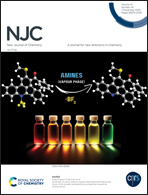Experimental study on the self-expanding sweep and microscopic oil displacement of amphiphilic carbon-based nanofluids
Abstract
Carbon-based nanomaterials possess numerous distinctive properties, such as their small size and interface effects. However, the practical utility of these materials is somewhat constrained under harsh environmental conditions like high salinity and elevated temperatures. To expand the potential applications of these promising nanomaterials, we present the synthesis of amphiphilic graphene oxide (GOA) from graphene oxide through the utilization of a silane coupling agent (KH550) and polyethylene glycol. We investigate the enhanced oil recovery efficiency and structural attributes of the synthesized GOA materials through a comprehensive approach involving experimental characterization, physical simulations, and nuclear magnetic resonance (NMR). The resulting GOA demonstrates excellent dispersion in brine (20 × 104 mg L−1) and exhibits remarkable stability even under high-temperature conditions (90 °C). The experiments have demonstrated that GOA can significantly reduce surface tension and oil–water interfacial tension, even at a low critical concentration of 40 mg L−1. The amphiphilic nature of GOA allows it to adsorb onto solid surfaces, altering the contact angle from 110.9° to 93.7°. This exceptional interfacial behavior enables GOA to modify the oil–water interface, resulting in the creation of a Pickering emulsion with 3.2 times higher viscosity compared to that of crude oil, even at 80% water content. This highly viscous emulsion can increase the resistance to seepage to modulate formation inhomogeneity. Online NMR replacement experiments reveal that injecting 0.6 pore volumes of GOA can enhance recovery rates by 19.7% compared to conventional brine displacement methods, facilitating the extraction of previously unrecovered crude oil from confined pore spaces. We anticipate that this high-performance material will find diverse applications within the petroleum industry in the future.



 Please wait while we load your content...
Please wait while we load your content...